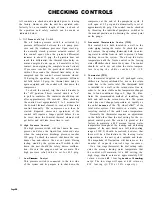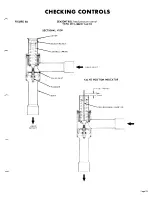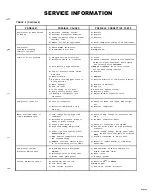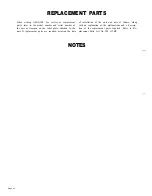
SYSTEM COMPONENTS
THERMOSTATIC EXPANSION VALVE
A.
B.
c.
D.
The expansion valve performs one specific func-
tion. It keeps the evaporator supplied with the
proper amount of refrigerant to satisfy the load
condition.
The sensing bulb of the expansion valve is in-
stalled in the closest straight run of suction line
from the cooler. The bulb is held on by clamps
around the suction line to assure firm contact with
the line. The suction line is then insulated to re-
duce the effect of surrounding ambients. In case
the bulb must be removed, simply slit the insulation
on each side of the bulb, remove the clamps and
then remove the capillary tubing that runs along
suction line from the valve.
The power element is removeable from the valve
body without removing the valve from the line.
This requires pumpdown.
Ambient temperature changes have an effect on the
performance of most thermostatic expansion valves.
With drop in ambient, the control bulb apparently
has a tendency
to
lose somcof its controlling char-
acteristics, which has the effect of increased super
heat. Consequently, special power elements for
thermostatic expansion valves unaffected by ambi-
ent are provided for all outdoor units.
CAUTION: Standard p ower
expansion valves should not
low ambient periods because,
summer conditions,
element thermostatic
be readjusted during
as ambient again ap-
the valve will flood
through and damage the compessor. Furthermore,
compressor manufacturers do not warrant compres-
sors obviously damaged by refrigerant flooding.
WATER COOLER
A. The water cooler is of the direct expansion type
with removable internally finned tubes and heavy
terneplate baffles. The copper tubes are individu-
ally rolled into heavy duty, steel tube sheets and
s c a l e d by a cast steel r e f r i g e r a n t h e a d .
B. The water connection nozzles which enter and
leave the shell are on the same side of the unit.
No special attention is required for the cooler
except that clean, filtered water should be supplied.
COOLER FREEZE PROTECTION
Cooler freeze protection is of major concern in the ap-
plication of air cooled water chillers. To protect
against freeze-up, a heater cable is provided as stan-
dard which protects the cooler to -2OF ambient out-
door air conditions. The control thermostat senses a
combination of ambient and cooler water temperature.
It thereby protects against water freezeup, at the same
time prevents excessively high water temperatures
during extended low ambient periods. Since there
would be no protection in the event of power failure,
or heater cable burnout, the following recommendations
are
A.
B.
C.
D.
intended to provide additional protection:
Drain the cooler and chilled water piping if the
chiller is not to be operatedover the winter months.
Two drain connections are provided on the cooler
to facilitate draining.
Maintain continuous water flow through the cooler
even when the compressors arc not operating.
Add ethylene glycol to the chilled water system to
provide antifreeze protection. Freeze point should
be approximately ten (10) degrees below minimum
design ambient temperature.
CAUTION: The use of ethylene glycol s o l u t i o n
will reduce the chiller capacity norma1ly b y 2 to 6
percen
t
depending on the concentration, and this
should be taken into consideration in system de-
sign.
Bypass water from the heating system through the
cooler during winter months. This can be accom-
plished by use of a small circulator pump arranged
to operate independently of the heating system and
p i p e d to maintain a small flow of water continu-
ously through the cooler. Water temperature must
not exceed 125F.
Page 27




































